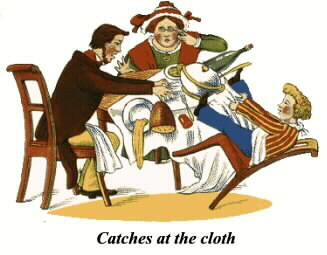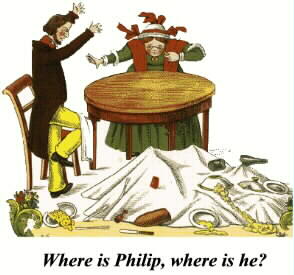ADHD (Attention Deficit Hyperactivity Disorder) also called Hyperkinetic Disorder and ADD (Attention Deficit Disorder) are conditions increasingly diagnosed in the industrial western world during the last two decades. In spite of the authoritative style in which this subject is often presented in the media, ADHD research is still in the area of hypotheses and not fact.
It is the most diagnosed childhood psychiatric condition, yet it is also the most misdiagnosed and misunderstood childhood behavioral condition.
ADHD history as a documented disorder is now a little over 200 years old. In 1798, the Scottish physician Alexander Crichton described quite accurately the behavior pattern now called Attention Deficit Hyperactivity Disorder.
In his book, with the dreadful title, “An Inquiry into the Nature and Origin of Mental Derangement,” Crichton described it as a “mental restlessness” and wrote that his patients call it “The Fidgets.” Interestingly he was way ahead of his time, noting that people were either born with it or that it was the effect or result of the accidental disease. Illnesses such as hypothyroidism and early-onset diabetes are some of the 100 odd causes of attention deficit and hyperactivity. He also noticed that as the person got older the symptoms diminished. This is due to maturity and intuitively learning coping strategies.
He even touched on one of the most important causes of attention deficit in school, an intolerance of boredom, when he wrote, “Every public teacher must have observed that there are many to whom the dryness and difficulties of the Latin and Greek grammars are so disgusting that neither the terrors of the rod nor the indulgence of any kind entreaty can cause them to give their attention to them.”
Crichton recommended special educational intervention for these children and noted that it was obvious that they had a problem with keeping attention no matter how hard they tried. What was commendable with Crichton’s observations was that he did not show the bigoted moralizing arrogance with which George Still, a hundred years later, set the tone of authority’s attitudes towards children with ADHD. This arrogant attitude can still be found in some of the foremost figures in ADHD research today.
In 1904, about a hundred years after Crichton’s observations, the British pediatrician, George Still, published in the British medical journal, The Lancet, a description of a set of behaviors he called, “a morbid defect of moral control” which he believed to be “volitional inhibition” disorder. We do not know what these children had. They could have been emotionally disturbed or had Oppositional Defiant Disorder (ODD) or Conduct Disorder (CO) and not what is today considered as ADHD, although they still have the symptoms of attention deficit, impulsivity, and hyperactivity.
George Still’s basic error of calling a pattern of behaviors a disorder is still with us today. This condition we now call Attention Deficit Disorder is complex, individual, and difficult to generalize, so we categorize it and give it a label to solve the problem. Basically, researchers are searching for some kind of easy formula to explain a condition that is very complex. A brief review of the literature would show any open-minded scientist with common sense, and with a basic understanding of the difference between cause and effect, that we are dealing with many varied conditions with a limited set of symptoms in common.
Correlation does not imply causation. A relationship between two variables does not imply there is a cause-and-effect relationship between the two.
A symptom is not a disorder; the cause of the symptom is the disorder.
George Still had only twenty patients, unlike today’s almost epidemic number of ADHD diagnoses. Looking at the range of causes of ADD/ADHD behavior it is most likely that his twenty patients had the more difficult and extreme ADHD behaviors. This means they probably were antisocial. They were not the hyperactive-child-next-door variety of ADHD children. They stuck out in that society that was more tolerant of hyperactive children. This would mean that his patient was likely to have Opposition Defiance Disorder, Conduct Disorder or an extreme form of autism. Autism was still an unknown condition in 1904.
Note on autism: Autism is a spectrum disorder defined by a problem with social contact and most autistic people would not be in Still’s patient group. Autistic people have contributed greatly to humanity’s development in science, philosophy, literature, etc. We would not have computers today if it were not for some autistic mathematical geniuses who made computing possible.
Hippocrates (460 to 370 BC) made the first mention of attention deficit, as he described an ADHD-like behavior. Aristotle probably had ADHD, as did Galileo, Leonardo da Vinci, Newton, Einstein, Picasso, Robin Williams, Whoopi Goldberg, Richard Branson, and a long list of people who have benefited humanity and brought us to where we are today in fields as varied as science, technology, economics, mathematics, and the arts. ADHD personalities have innate creativity, enthusiasm, and intuitiveness if it is not suppressed by misguided education.
There is a paradox with attention deficit and that is that attention-deficit people have the ability to hyperfocus. However, this is difficult to study because the act of observation in a study tends to put the person into attention deficit. The school has the same effect of inducing boredom intolerance and attention deficit. This is a complex subject for which there is no magic recipe.
Shakespeare also mentioned adult attention deficit in Henry VIII, calling it a “malady of attention.”
In the 19th Century, hyperactivity was again mentioned in literature. Dr Heinrich Hoffman, a German doctor, and author, wrote a collection of poems for children called “Der Struwwelpeter” in 1844. The poems, with entertaining illustrations on each page, were about some nasty little children and some sad stories. Hoffman’s humor was like an ornery Roald Dahl. One of the poems was “Die Geschichte vom Zappel-Philipp” or “The Story of Fidgety Philip.”
The Story of Fidgety Philip

“Let me see if Philip can
Be a little gentleman;
Let me see if he is able
To sit still for once at the table.”
Thus Papa bade Phil behave;
And Mama looked very grave.
But Fidgety Phil,
He won’t sit still;
He wriggles, And giggles,
And then, I declare,
Swings backward and forwards,
And tilts up his chair,
Just like any rocking horse.
“Philip! I am getting cross!”
See the naughty, restless child,

Growing still more rude and wild,
Till his chair falls over quite.
Philip screams with all his might,
Catches at the cloth, but then
That makes matters worse again.
Down upon the ground they fall,
Glasses, plates, knives, forks and all.
How Mama did fret and frown,
When she saw them tumbling down!
And Papa made such a face!
Philip is in sad disgrace.
Where is Philip, where is he?

Fairly covered up you see!
Cloth and all are lying on him;
He has pulled down all upon him.
What a terrible to-do!
Dishes, glasses, snapped in two!
Here a knife, and there a fork!
Philip, this is cruel work.
Table all so bare, and ah!
Poor Papa, and poor Mamma
Look quite cross, and wonder how
They shall make their dinner now.
In the aftermath of the encephalitis epidemic in North America in 1917-1918, many survivors showed ADHD-like behavior. This resulted in the condition being upgraded from a “Morbid Moral Defect” to “Minimal Brain Damage” and then later to “Minimal Brain Dysfunction.” The assumption was the survivors had suffered some brain damage. It had been observed that head injury, disease, and congenital defects affected behavior.
In 1937 it was discovered by chance that stimulants, like amphetamines, resulted in calming restless children. The Second World War probably caused these researchers to lose their focus, as the practice of drugging children with Schedule II drugs was not at first implemented. It was not until the late 1950s before giving stimulant drugs to young children became routine. By the mid-1960s this was a usual treatment for what was then still called “Minimal Brain Damage.”
In the 1960s Minimal Brain Dysfunction was relabelled as “Hyperactive Child Syndrome.” The researcher who coined this phrase, Stella Chase, thought her syndrome had a biological cause. There was no consensus on this, as many other researchers believed the cause to be environmental. There is a long list of conditions, which result in ADHD behavior.
Then in 1980, the American Psychiatric Association, by a vote of hands in a committee meeting, added Attention Deficit Disorder (ADD) to the diagnostic list. From this point on the epidemic started, fuelled by big pharma’s marketing campaigns. Many researchers who today are considered leading authorities on the subject of attention-deficit are funded, directly or indirectly, by the pharmaceutical industry. This has led to the schism between authoritative researchers and doctors who, on the one hand, are focused treating the cause of attention deficit, and on the other hand those fixated on masking symptoms by medication.
This can be summed up as follows:
- Find the cause and fix it, or
- Suppress the symptom and the problem is solved.
As our knowledge stands today, no researchers fully understand ADHD themselves. Some aspects of ADHD and ADD are outside modern science and in the sphere of philosophy. Many researchers are so busy digging their hole in their particular niche, that they have lost sight of the hugely complex subject they are referring to.
In 1987, ADHD was voted in by a similar informal vote, and placed into the DSM-IV (The Diagnostic and Statistical Manual of Mental Disorders).
Ritalin, Adderall, and Concerta have all been marketed with an aura of scientific exactitude and responsibility behind them. Too many physicians accept what the pharmaceutical industry says without question. It is after all much simpler to medicate than to treat the patient with natural remedies for ADHD. Their consciences are stilled by the advertising mantras churned out by big pharma.
In 1998 this situation with no consensus between the pharmaceutical companies and their doctors on one side, and doctors who focussed on treating their patients on the other. The National Institute of Health (NIH) held a “Consensus Development Conference.” This defined the “consensus” attitude which we still have today.
Quotations from the “Consensus Developmental Conference” report:
“Despite progress in the assessment, diagnosis, and treatment of ADHD, this disorder and its treatment have remained controversial, especially the use of psycho stimulants for both short- and long-term treatment. Although an independent diagnostic test for ADHD does not exist, there is evidence supporting the validity of the disorder. Further research is needed on the dimensional aspects of ADHD, as well as the coexisting conditions present in both childhood and adult forms.”
“We do not have an independent, valid test for ADD/ADHD and there are no data to indicate that ADD/ADHD is due to a brain malfunction.”
“Finally, after years of clinical research and experience with ADHD, our knowledge about the cause or causes of ADHD remains largely speculative. Consequently, we have no documented strategies for the prevention of ADHD.”
In spite of that, this set the tone and direction of ADHD research for the next decade. The research is so focused on a neurological disorder (one cause) that there is a lack of research on multiple causes. This ignores the possibility of a hundred children with ADHD behaviors could have these symptoms from a hundred different causes or combinations of causes. Causes can be anxiety, frustration due to learning difficulties, or frustration from boredom due to under-stimulation in the classroom, allergies, and many many more.
In 1998 they said ADHD was controversial.
They did not have an independent validated test, such as a biological or blood test.
They admitted they had no proof that ADHD was a disease, as there was no a proven biological basis for ADHD.
That was in 1998, and neither do they have any test or proof in 2010.
A doctor diagnosing ADHD in a child today, uses subjective reports on perceived behavior of that child, from teachers and parents. Then they look into the DSM-IV (Diagnostic and Statistical Manual of Mental Disorders 4th edition) and base their diagnosis and decision to medicate, with powerful and addictive drugs, on this subjective base.

What are the DSM-IV criteria based on? The committee of the DSM-IV meets in a committee room and by a show of hands, vote into existence the disorder of the day, and give it a code number in the DSM. That is how we get so many psychiatric disorders. No ADHD or ADD physiological tests or criteria are considered today, which means little has changed in 100 years, except that we are more confused now. ADHD as a disorder is an opinion, not a fact.
ADHD is real! The error is in calling it a disease. The main problem in Attention Deficit Hyperactivity Disorder is the last term, “disorder.” If we called it dysregulation instead, then we could have Attention Deficit Hyperfocussing Personalities. Even the “Attention Deficit” part is misleading. So-called attention-deficit people can be hyper focussed if they are interested and stimulated. The problem is that they cannot regulate when they are in attention deficit or hyper-focus. This is situational. An adult can create an environment where s/he can get into the hyperfocus mode, but a schoolchild cannot, unfortunately, create an ADHD-friendly classroom.
Do we have difficulties with attention deficit? Sure we do, but having a disorder makes us victims, being enthusiastic, creative, and able to focus makes us conquerors.
On a personal note; I have an attention deficit and experienced a nervous breakdown trying to be “average.” Now I am modifying my lifestyle around my Attention Deficit Hyperfocussing Personality. I take certain supplements, which definitely help me focus, but I have little sense of time, am still forgetful, sort of scatterbrained, and avoid boring tasks. So I concentrate on what I can do well and delegate what I cannot do. My wife tells me 15 minutes before when it is time to get ready to go out. I go early to appointments, sometimes getting there half an hour early.
It is about time the history of ADHD started to focus on the positive sides of the attention deficit hyper focusing subject.



